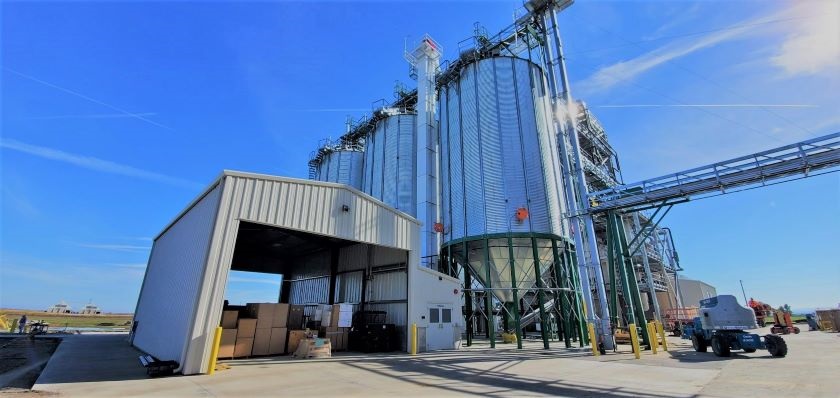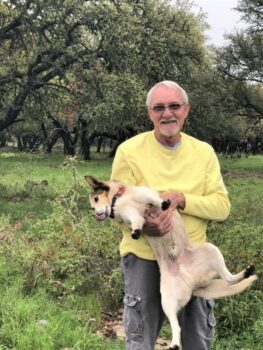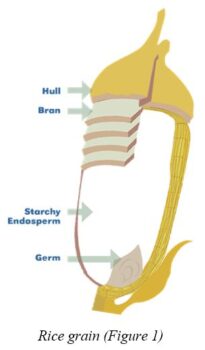
 When you think about rice, you probably think about the fluffy, white grains that you eat for supper. However, while that’s certainly the tastiest part of the rice, it’s not the whole story, as Steve Linscombe, Executive Director of The Rice Foundation, explains.
When you think about rice, you probably think about the fluffy, white grains that you eat for supper. However, while that’s certainly the tastiest part of the rice, it’s not the whole story, as Steve Linscombe, Executive Director of The Rice Foundation, explains.
He outlines how the use of rice’s by-products is growing, from providing alternative animal feed sources to sustainably powering our electricity.
There’s More to Rice than Rice
A grain of rice (Fig. 1) consists of an inedible outer covering (hull), the edible bran layer below the hull, and the white rice kernel.
 After harvest, the rice grains are first run through a huller to remove the hull. At this point in the process, the remainder of the grain is called brown rice which is widely consumed and preferred by many as it is 100 percent whole grain and high in fiber. In most cases the milling process is continued to remove the bran layer, creating white rice. The rice hull is approximately 20 percent of the rice grain weight while the bran layer is normally about 10 percent. These two by-products, however, are not simply discarded. U.S. rice millers and exporters ensure that every part of the rice grain is used so that nothing is wasted.
After harvest, the rice grains are first run through a huller to remove the hull. At this point in the process, the remainder of the grain is called brown rice which is widely consumed and preferred by many as it is 100 percent whole grain and high in fiber. In most cases the milling process is continued to remove the bran layer, creating white rice. The rice hull is approximately 20 percent of the rice grain weight while the bran layer is normally about 10 percent. These two by-products, however, are not simply discarded. U.S. rice millers and exporters ensure that every part of the rice grain is used so that nothing is wasted.
Rice Hulls
While rice hulls are not suitable for human consumption, they are used in multiple ways, mainly for livestock feed, often mixed with the bran. However, they have many other uses. Many rice mills have adjacent bio-mass plants with very efficient furnaces that use rice hulls as an environmentally-friendly fuel source to generate electricity. This electricity, in turn, can be used to power the rice processing plant or in some cases it is put into the electrical grid, serving as an additional revenue generator for the mill. The rice hull ash that remains after burning can be used as a soil amendment which can increase the water and nutrient holding capacity and improve soil aggregation. The ash also serves as a filler in concrete production and is used as an insulation material in steel mills.
In some areas where rice and poultry production are relatively close, rice hulls are used as bedding for poultry. This is common in Arkansas where the state has large rice and poultry industries.
While sticky rice was used as mortar in the initial building of the Great Wall of China1, research is currently being conducted into using rice hulls as a component of building materials such as particle boards. Rice husks are fibrous by nature and require little energy input to prepare the husk for particle board manufacture.
Rice Bran
Most rice bran is used as an additive to livestock feeds, providing high levels of fiber. Sometimes the bran is mixed with rice hulls to create a feed additive with additional fiber levels for either livestock feed or pet food.
As consumers worldwide are becoming more aware of the ingredients in their food and are choosing healthier alternatives for fats and sweeteners, rice bran is becoming the option of choice. Rice bran is used to manufacture a high-grade oil used in cooking. Rice bran oil is known for its high smoke point of 232˚C and its many health benefits; it’s rich in Vitamin E and is known to help with treating diabetes, high blood pressure, high cholesterol, and obesity. Packed with antioxidant properties, rice bran oil is also used by some people, both internally and externally, to nourish their hair and skin.
Brown Rice Syrup
Brown rice syrup, while not strictly a by-product, is another interesting use of rice. It is made by cooking brown rice and subjecting it to natural enzymes, which helps break down and turn the rice’s starches into sugars. It doesn’t contain any gluten or fructose and has low levels of glucose. Rice syrup can be used for sweet making and other high-temperature cooking and is also used in the production of granola bars and snacks. Corn syrup and rice syrup have similar sweetness, consistency, and effect in food, which is why they’re often interchanged in recipes.
Rice is a staple food for more than half of the world’s population2. And as the above examples show, the adoption of its by-products, which account for 30 percent of the grain, is growing. From providing alternative feed sources for animals to sustainably fueling electrical grids, rice is the go-to grain that can not only feed the world but run it, too.
Note: A new rice hull energy production facility (pictured above) at American Commodity Company Rice Mill near Williams, California is scheduled to begin operation in early 2022.


